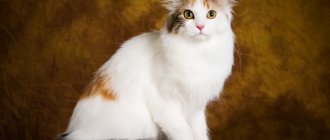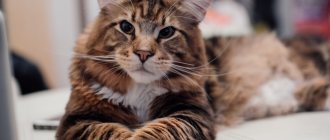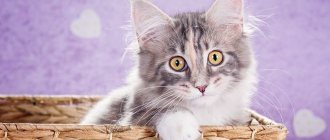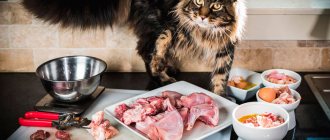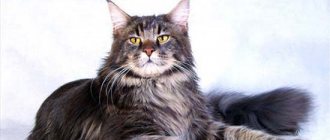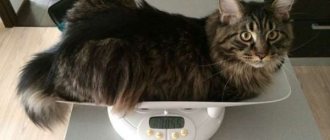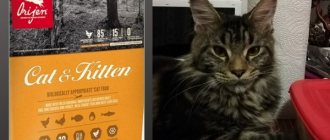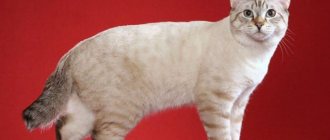Video
* We invite you to watch a video about the Maine Coon . In fact, in front of you is a playlist in which you can select and watch any of 20 videos about a given cat breed by simply clicking on the button in the upper right corner of the window. In addition, the material contains quite a lot of photos. By looking at them you can find out what a Maine Coon looks like.
In this article:
|
Rate the material!
[Total votes: 5 Average: 3.6]
Maine Coon cat nutrition
It is necessary to feed your Maine Coon cat high-quality, balanced food rich in protein and nutrients. Dry food must be combined with canned food. It is better not to take grain-based food for Maine Coons ; high-calorie carbohydrate foods can cause diabetes and obesity. The first ingredient in special food for giant cats is meat.
Description of nutrition on a natural basis - up to 70% of the diet should be meat and meat products, it is recommended to supplement the menu with eggs, porridge, vegetables, dairy and fermented milk products, be sure to accompany the diet with vitamin and mineral supplements. Feeding bowls should be made of glass or stainless steel; plastic is highly undesirable.
Read more in the article Proper nutrition of Maine Coons.
History of the origin of Maine Coons
Maine Coons emerged as a separate breed approximately 150-200 years ago. They originated from the cats of Maine in the northeastern United States. Literally, the name of the breed “ Maine Coon ” is translated as “Manx raccoon”, hence the second name – “Manx raccoon cat”. There is an opinion that this breed was bred artificially, but this is not at all true. This cat breed formed independently.
The breed owes its formation to natural selection. In fact, the ancestors of these cats were the pets of the first American settlers. Of course, the first cats that appeared on the continent were no different from European ones, with the exception of rich, long-haired breeds. By crossing with each other, they left a wide variety of offspring.
Cats were affected by harsh conditions: cold winters, extreme climates, difficulty in obtaining food, fighting large rodents, and others. All this led to the fact that only those cats could survive that were both strong and resilient, had long and warm fur, had powerful and wide paws, and also had above-average intelligence.
Not the least role in the formation of the breed was played by the struggle not only with environmental conditions, but also by the competition of cats with each other for the right to live in the territory and for the right to produce offspring. Therefore, only the strongest survived. In the 60s of the 19th century, the first mentions of the breed appeared. Maine Coons settled down well with farmers, who loved these cats for their large size and good hunting qualities as rat catchers.
Photos of Maine Coons
Photo No. 1
A huge adult cat is in the arms of a boy. The face has all the best features: marbled gray color, large head and paws, pointed ears with tufts, elongated body and long fluffy tail. It’s immediately obvious that they are true friends!
Photo No. 2
The red Maine Coon is a magnificent color and texture of the coat! A menacing look and a typical royal pose are a manifestation of the breed and internal qualities of the animal in all its glory. The largest features cannot go unnoticed - a massive nose, slanted eyes, high ears and wide cheekbones. A truly beautiful and graceful representative of the family!
Photo No. 3
The color of this cat combines several shades of gray and white. She easily and happily runs through the snow, in which the physiological structure of her paws helps her. Fluffy and thick wool is an excellent protection from wind and cold; at low temperatures, the lush undercoat expands and visually the animal becomes even larger. A regal and smart cat!
Photo No. 4
The Maine Coon is a peach-colored teenager, he has a playful and open look, and is interested in what is happening, which is typical for representatives of this breed. From the videos and photos of the Maine Coon breed, you can see typical features - a powerful nose and wide-set eyes, a beautiful collar and healthy pink ears, as well as large paws with tufts of wool between the toes. Cute, inquisitive and active pet!
Maine Coon - description of the breed
The Maine Coon is a strong, muscular cat with a rectangular body without unnecessary bends, with strong paws. As a rule, females are smaller than males. The chest is wide. The neck is of medium length. Some animals have a kind of collar or mane. The body has soft and thick fur; it becomes longer on the belly. Wool is waterproof. The undercoat is also thick and waterproof. The paws are large and round. There are tufts of fur between the toes. This breed often has multiple toes.
The animal's tail is long and fluffy, reaching to the shoulders. It is wide at the base and narrows towards the tip. The long tail serves as a kind of steering wheel for the cat and promotes coordination of movements. Not all animals have the raccoon stripes characteristic of many representatives of the breed. Moreover, from the point of view of the breed standard, they are not mandatory - nothing is said about them. The animal's muzzle is square, usually ending bluntly. It is sometimes even said that Maine Coons have a face rather than a muzzle due to the straight set of the eyes, rather than the typical slanted set of cats. The ears are large and pointed, set high, with tufts at the ends. The cat's eyes are bright and expressive, usually golden or green in color.
Let's figure out how much a Maine Coon weighs. So, an adult cat weighs on average about 6 kg, males - up to 8 kg. But there are cases where individual animals reached a weight of 12-13 kg and were absolutely healthy and not obese. The length of adult cats reaches more than a meter, of which the tail occupies about 30-40 centimeters. The height of the animal is from 25 to 41 centimeters. But despite their impressive size and weight, Maine Coons are very agile cats with excellent coordination.
Interesting fact: Compared to other cats, Maine Coons develop slowly. They reach maturity only at four to five years of age. The average life expectancy at home is 12 to 15 years.
Signs of the Maine Coon breed
The Maine Coon's calling card is its large head and paws, slanted eyes and high ears with tufts, a powerful build and a long fluffy tail. Why not a domestic lynx?!
The unique appearance dictates the following standards and description:
- Body. A voluminous rectangular body with developed and massive muscles, a large head and strong limbs, a wide chest cage and a very long tail.
- Head. A large head with straight and sharp outlines, with a large nose and raised cheekbones.
- Eyes. The almond-shaped eyes are widely spaced, their color is in harmony with the general shade of the animal.
- Ears. The large ears are wide at the base, set high and vertical, they are pointed and end with tufts typical of Maine Coons, like those of lynxes.
- Chin. A strong and large chin is in line with the lips and nose.
- Tail. The long and bushy tail should reach the shoulder, it is wide at the base and tapers slightly towards the tip.
- Paws. Stocky paws of medium length, with small tufts of wool between the toes.
- Color. Nature has endowed the breed with a wide variety of coat shades. They have Siamese, red, chocolate, white, peach and black colors.
- Wool. The head and shoulders of the animal are covered with short hair, which lengthens along the back, sides and belly. The outer coat falls smoothly, feels hard to the touch, and has a thick and lush undercoat. There may be a frill or collar around the neck.
- The weight of a large female can reach 9-10 kg, a male – up to 11-12 kg, the average body weight of the animal is 7-8 kg. Kittens are born weighing up to 150 to 170 grams, for comparison, the weight of a normal cub is only 70-110 grams.
- Age. Maine Coons live on average from 10 to 12 years, long-livers are marked by 15-16 years of life.
Among the most popular breeds in the world, Maine Coons took an honorable 3rd place, giant cats were second only to Persians, who took 1st place, and exotics, which took 2nd place!
Popular Maine Coon colors
Colors based on primary colors are black (also known as black marbled), red (or its common name is red), cream and blue Maine Coon (common name is grey). However, solid colors are rare in these cats, and they usually have a brindle pattern or spots.
Based on this, all Maine Coon colors are usually divided into four categories:
- Solid (from the English solid) – solid color;
- Tabby (from English tabby) – striped color;
- Smoky;
- Tortoiseshell spotted.
The classic tabby (also known as marbled tabby) is characterized by wide spiral stripes that are located on the sides of the animal. Sometimes these stripes are very similar to marble stains. Very common are Maine Coons with the brindle tabby color, which got its name because it resembles the color of a tiger - the stripes are located vertically and parallel to each other. Some cats have a ticked tabby, a color in which there are no stripes or spots on the skin, but there is a pattern on the animal's face, or on its chest or paws.
The smoky color in its visible appearance resembles creeping smoke. The hair may be gray or even distinctly white at the roots, but the ends may be blue or black. This color looks very beautiful, especially when the animal is moving, when the movement of the fur creates a shimmering effect. Only cats have a tortoiseshell color, that is, with multi-colored spots, since cats cannot have more than two colors with very rare exceptions due to genetics.
Raising a Maine Coon
So, these cats are very flexible and can be trained without any problems. Of course, they don’t have to be trained, but they should be accustomed to a litter box, a scratching post, and proper behavior in the apartment. Maine Coons have an excellent memory, allowing them to easily remember and learn anything new.
To prevent your pet from getting bored, buy him some toys and install climbing frames. Firstly, the animal will be in motion, which is incredibly beneficial for its health, and secondly, it will prevent damage to property. If you wish, you can teach your Maine Coon some simple commands; affection, praise and treats will help you with this.
Character and habits of Maine Coons
The character of Maine Coons is different from that of traditional cats. They are very reserved and balanced. Quite calm, practically do not show aggression or anger, and do not extend their claws. They are very patient and even when irritated they do not bite or scratch. In their relationship with humans, Maine Coons are trusting, friendly and sociable. They get along easily with other cats or dogs.
Because of this feature, the breed is most often recommended to families with small children. But at the same time, Maine Coons have a developed sense of dignity and self-control. For example, they can stay close to their owner for a long time, but at the same time they will not allow themselves to be placed on their lap. They are also quite delicate and not intrusive. Unlike other cats, it is not customary for them to beg for food.
These cats are very playful. They are active and for this reason it is difficult to classify them as “couch” animals. They spend most of their free time playing or jogging; they constantly need to perform some kind of action or do something. Even ten-year-old cats love to play, while other breeds at this age are characterized by constant rest.
Interesting fact: Very often Maine Coons use their paws to help. For example, they can hold a toy with their paws and remove litter from the water. In this behavior they are similar to raccoons.
The intellectual abilities of Maine Coons are also noted. Cats are able to remember dozens of commands, they can easily navigate by the owner’s intonation, and understand gestures and facial expressions. They also fundamentally divide everyone around them into “us” and “strangers”. Among household members, they often choose the main owner with whom they are willing to spend more time. Often this becomes the eldest child or the head of the family. They are wary of strangers, but at the same time demonstrate goodwill and calm. They often distance themselves from guests in the house.
Disadvantages of Maine Coons
Representatives of the breed have few disadvantages, they relate to the peculiarities of the content:
- Animals need feed developed in accordance with the requirements of the breed.
- They need a lot of food.
- The consumption of filler is several times higher than when keeping ordinary cats.
- The Maine Coon's coat requires regular care. Representatives of the breed are combed two to three times a week.
Interesting facts about Maine Coons
The Maine Coon is the largest breed of domestic cat. It’s not for nothing that they are called giant cats. They are large both in length (the record is 123 centimeters) and in mass. They also have long whiskers and whiskers (the record is 19 centimeters). And their tails have the greatest length in relation to the total length of the body.
Maine Coons are capable of making sounds that cannot be heard from other cats, for example, cooing, whistling, purring, and chirping. They have vocal abilities and express their emotions with many sounds. Very often they try to conduct a dialogue with the owner.
Among the unusual habits, noteworthy is the love of water, swimming and playing with water. Not only are they not afraid of water, but they even ask to take a shower themselves. They are also characterized by a love of walking. These cats respond well to collars and often like to follow their owner through parks or alleys.
Maine Coons are quite easy to train, for example, they can be taught to fetch slippers or open the door. They learn to go on the toilet very easily. They have tufts on their ears, very similar to those of lynxes. Animal fur does not get wet and, in addition, can withstand extreme sub-zero temperatures.
Polydactyly (polydactyly) is very common among Maine Coons. One paw may have six, and sometimes more, toes with claws. Some cat researchers estimate that up to 40% of "early" Maine Coons were polydactyly. Nowadays, most felinological organizations consider polydactylism undesirable, which is why many cats are not allowed to participate in exhibitions. But there are standards by which it is not a defect. These big cats are also very fertile. One litter can contain up to ten kittens.
Breed standards
For the Maycoon breed, the current standards today are those created by:
- WCF (World Cats Federation);
- TICA (The International Cat Association);
- FIFe (Federation International).
Each of these systems has its own nuances, but the general parameters are still similar.
| Body | The average weight of an adult is 8–10 kg. If this norm is exceeded, the pet is considered obese. The height at the withers does not exceed 45 cm, and the length reaches 135 cm. These parameters are suitable for cats, while cats are slightly smaller. With an elongated body and stocky build, the breed has pronounced muscles that show the strength and power of an aboriginal cat. The substantial, medium-length neck is framed by thick, collar-like fur. Powerful chest, long tail, strong paws and large feet with bushy hair between the toes. |
| Head | The wedge-shaped head is medium in size. In cats it is much larger than in cats. Rounded forehead, well-defined cheekbones. Nobility in appearance. A medium nose and a square chin, which runs in the same plane as the nose and upper jaw. |
| Eyes | Oval in size with an expressive and pure color that does not always match the coat color. |
| Ears | Large representatives have a triangular shape and a sharp tip, as well as a high delivery with a slight slope. Some are characterized by small tassels, like those of a lynx. |
| Wool | Wool is an indicator by which breed standards are determined. The fur has a smooth and elastic texture that can adapt to both heat and cold. Thanks to the structure with guard hairs and down, a thermos effect is created. The coat is long throughout the body, with slightly shorter fur on the shoulders and crown. A distinctive feature of the breed is a huge mane, but its presence is not considered mandatory. |
| Color | The permitted colors in the standards also differ greatly. Thus, the WCF and FIFE standards prohibit chocolate, cinnamon, point and other colors. In TICA, in no case can one classify a maikun with single spots and specks as a standard. |
Pros and cons of Maine Coons
The main disadvantage was that the breed became susceptible to various diseases, especially genetic ones. Large weight very often leads to an increased likelihood of injury to the animal. Also, the large size of the animal leads to increased nutrition. Thus, keeping a Maine Coon is more expensive than keeping regular domestic cats.
Due to their thick fur, animals produce a lot of hair, especially during molting periods. It is recommended to brush Maine Coons regularly, at least twice a week. A concomitant disadvantage is that the excrement is too abundant and has a very pungent odor.
In addition to the fact that these cats have a spectacular appearance, are beautiful and unusual, among the advantages should be noted the good nature of the representatives of the breed, learning ability and the ability to train. They are very smart and easily play with cat puzzles and learn tricks. Maine Coons are not vindictive and are not inclined to harm their owners out of resentment. They are not intrusive, for example, they prefer to sleep separately on the floor or on a windowsill, rather than trying to climb into the bed of their household members. They adapt quite easily to the rhythm of life in a particular family. Very neat. Maine Coons also get along well with children and other pets.
Among other things, they have advantages that are not relevant for urban conditions. In particular, they are excellent mouse hunters. Unpretentious to food. Very strong and hardy, adapted to cold climates.
Habits and habits of the Maine Coon
The description of the Maine Coon contradicts the external severity and menacingness of the animal; in reality, it is a friendly and playful cat, the sight of which makes you want to smile. They get along well with children, play and protect them. The only contraindication to owning a Maine Coon is an allergic reaction to the animal's fur, since they are subject to shedding almost all year round.
Pets of the Maine Coon breed are not afraid of harsh winter conditions - they have a specially shaped paw for walking on snow, dense water-repellent fur and a huge fluffy tail, which can be used to cover and hide from severe frost.
Unlike representatives of other breeds, the description of the Maine Coon cat breed is associated with a love of water and bodies of water. The Maine Coon will not refuse to take a bath and swim with the owner, ask to take a shower with you, will happily climb into the bathtub and will not refuse to wash himself under the tap.
Maine Coon Breeding
When breeding Maine Coons, you should take into account some features of this breed. For example, their development differs from other smaller domestic cats. Each Maine Coon individual takes longer to develop and reaches sexual maturity by one and a half years, perhaps a little earlier. However, you should not breed a cat until the fourth year of life. By this time, you can determine the purity and quality of the breed, ensure its health, and establish itself in the cat market.
You should approach the choice of a Maine Coon male no less carefully; he must meet the breed standards and, best of all, he must participate in mating not for the first time. This way you can evaluate the quality of the breed by its previous offspring.
As soon as all the nuances are clarified, you can start knitting. A pregnant cat should be treated with special care, provided with rest, a balanced diet, and additionally fortified with recommended vitamins and minerals.
Interesting fact: Pregnancy in Maine Coons lasts a little longer than in other cats. Typically, from one to six kittens are born, which are usually blind and helpless. They also develop more slowly and feed on their mother's milk. If there is a lack of milk or weakness and low mobility in some kittens, you should consult a veterinarian about complementary feeding.
In a couple of weeks, the kittens will begin to see clearly and begin to develop much faster. We need to ensure their safety indoors. Kittens become very strong and look like adults only at 4–5 months of age. By seven months, cats may begin to come into heat, and cats may begin to mark their territory, but these are just the first urges. They begin to experience the real rut later.
Maine Coon diseases
Breeding in harsh conditions has made representatives of this breed very hardy, however, they also have some possible diseases.
Pelvic dysplasia is the most common disease. The animal experiences pain with any activity, becomes inactive, and lameness may appear. Your pet can get sick at any age; treatment will require expensive treatment, possibly surgery. This disease is hereditary, so when buying a kitten it is better to immediately request x-rays of both parents.
Hypertrophic cardiomyopathy is a heart disease characterized by thickening of the ventricular wall. It can also be inherited.
Note!
Canadian Sphynx: 105 photos, detailed description of the breed, tips on choosing kittens and the character of the catSiberian cat - description, content, breed standard, character and intelligence of the cat (90 photos + video)
Neva Masquerade cat: description, character and advantages of the breed. Features of raising and caring for a cat (105 photos + video)
Spinal muscular atrophy can be detected in a kitten only by external signs, since this disease is not accompanied by pain. General dystrophy is observed, the animal acquires an unnatural, “swaying” gait.
Maine Coon Care
Caring for Maine Coons is much like caring for any other beloved pet. These animals must be vaccinated against common dangerous diseases such as rabies, panleukopenia, rhinotracheitis or calcevirosis. From time to time it is worth paying attention to the condition of the animal’s mucous membranes, as well as its fur. It would be a good idea to carry out regular anti-tick therapy. Be sure to worm your pet every six months.
Maine Coons need a spacious room. Before you adopt such a large cat, you need to think about the space for its existence. It is also worth remembering that due to their large size, they consume more food than other domestic cats. Sometimes keeping such an animal is much more expensive than keeping other animals. The food must also meet the requirements of this breed; you should definitely consult a specialist about this.
Maine Coons have very long fur and require special care. They need to be brushed every few days so that they swallow as little hair as possible when licking. Hairballs lodged in a cat's stomach and throat can cause coughing, vomiting and discomfort. To make it easier for them to pass through the gastrointestinal tract, cats are given special pastes that remove hairballs.
You can add it to the food or try to give it separately. For thicker and shiny fur, it is fashionable to give animals various nutritional supplements, but you just need to make sure that they do not indicate allergies. And finally, you should decide right away whether you will breed Maine Coons! If not, then the animal should be sterilized.
Character of the breed
In order to better understand what kind of cat you take into your home, it is worth remembering that at one time Maine Coons were especially popular among hunters and also served as home guards.
These are very loyal cats to their owner, reminiscent of dogs in disposition. They are distinguished by a high level of intelligence and a desire to communicate. Curiosity allows them to remain funny pets until old age.
The main thing in keeping a Maine Coon is to remember his need for freedom. Excessive activity does not allow them to remain locked up for long.
Note!
British shorthair cat - description of the contents, selection of food, personality traits and breed (105 photos)Scottish fold cat: detailed description of the breed, character and maintenance features (100 photos)
Abyssinian cat: review, description of the breed standard and character. 115 photos and videos of cats
Despite their noble origin and thoroughbred, Maine Coons need constant walks in the fresh air. This is not a decorative pet, but a wild and independent cat.
They get used to the harness and leash quite quickly, tolerate temperature changes well and can walk in any weather: water-repellent thick fur and powerful paws will protect them in rain and snow.
Maine Coon diet
It is immediately worth noting that Maine Coons consume much more food than all common domestic cats. Since the animal is purebred, the food should be chosen specially for the Maine Coon breed. It is balanced and designed specifically for the characteristics of these cats. Of course, Maine Coons are fed not only with dry food.
The following types of food are suitable for them:
- Boiled poultry, rabbit, lean beef;
- Liver, heart;
- Boiled sea fish;
- Vegetables: carrots, beets, zucchini, pumpkin;
- Dairy products: cheese, sour cream, kefir;
- Eggs;
- Fiber and bran.
Some foods are not recommended to be given to animals, and for old animals they are even prohibited.
These include:
- Poultry and animal bones;
- Fatty meats (pork, goose, lamb);
- Smoked meats and sausages;
- Salty and sweet foods;
- Legumes;
- Fresh milk.
It is very good to give cats sprouted oats. If you take cats outdoors, they themselves can consume the grass they like. It is interesting to note that Maine Coons can hit a cup of water with their paws. This reflex was left to them from their ancestors; they are trying, as it were, to clear the water of the dust that has fallen into it. It is worth keeping this fact in mind and placing the bowl large and heavy so that the cat does not turn it over. You can use special drinking devices.
Description of the character of a Maine Coon cat
The unique appearance is accompanied by an equally interesting description of the character and habits of these animals. Here's why Maine Coons are special:
- Sociability and communication skills. The character description of the Maine Coon breed begins with the fact that they hate loneliness. On the contrary, they should be the center of attention and in the thick of all the events that happen in the house. Cats sleep little, like to contemplate from the outside, adapt well to the rhythm of life of their owners - in general, over time they become equal members of the family.
- Kindness and friendliness. The Maine Coon cat can be described as showing absolutely no aggression. It does not happen that during play they begin to release their claws and hiss, as often happens with other breeds. Their menacing appearance does not at all coincide with their kind and gentle soul.
- Intelligence and resourcefulness. The intelligence of Maine Coons is at the highest level, cats can learn many commands and games, they are understanding, logical, intelligent and resourceful animals. They can open the door with their paws, fetch various objects, go to the toilet, catch toys, eat from their paws, stand on their hind legs, and so on.
- Playfulness and curiosity. Until his old age, the Maine Coon is interested in everything, he leads an active life and remains a “child”, a bully and a naughty girl. Apparently these cats are haunted by the hunting instinct hidden in them.
- Love and affection. There is no limit to the love and affection of these pets, but this does not mean at all that they will sit in your arms. Maine Coons show their love in this way: they rub at the feet, lie next to each other, lean against each other, purr and poke their faces. Description of the favorite habit of a Maine Coon of any age is to sleep with its owner.
- Activity and freedom. Walking for a Maine Coon is a necessary and important attribute of their life. They will go for walks in any weather and quickly get used to the collar and leash. Description on the street: they behave calmly, they will not run away or hide.
- Openness and agreeableness are the main characteristics of the Maine Coon breed. They can live in any family. If a Maine Coon is surrounded by many children, then he will definitely choose his favorite. With small children the cat is polite and tactful and will never touch the baby. If there are other pets in the house, it doesn’t matter whether they are cats, birds, rodents or dogs, the Maine Coon will become an excellent companion and friend.
- Neatness and cleanliness. For all its grace, the Maine Coon can be clumsy - scatter food around the plate, spill water, knock something over on the floor. In terms of toilet and hygiene, these cats are extremely neat and clean.
An interesting question: what distinguishes Maine Coon cats from male cats? According to physiological indicators and description, males are much larger than females. According to reviews from owners, cats are more affectionate and gentle, but more independent and self-sufficient. Moreover, it is females who are better hunters than representatives of the opposite sex. The most vividly predatory instinct awakens in them when offspring are born. In behavior with the owner, the male resembles a “faithful dog”; the feelings of devotion and gratitude of the Maine Coon have no limits.
© shutterstock
Diseases and health problems
In general, Maine Coons, as a naturally occurring breed, have high levels of endurance. But, nevertheless, these cats are prone to some genetic diseases.
The category of hereditary diseases for Maine Coons includes:
- Pathologies of the musculoskeletal system;
- Diseases of the urinary system;
- Skin diseases;
- Problems with the cardiovascular system.
Purulent joint diseases such as arthritis, synovitis, capsular phlegmon will require special attention. They can occur as a result of mechanical damage or due to the penetration of staphylococcal or other infections. Older cats develop arthrosis and deforming inflammatory processes in the joints.
With an incorrect diet and due to hereditary predisposition, eczema can occur. A sick animal itches a lot and loses weight, and pustules form on its skin. As with other cat breeds, Maine Coons are characterized by urolithiasis, the main cause of which is insufficient water intake.
Genetic diseases of the breed also include hypertrophic cardiomyopathy, in which the heart muscles become too dense, as a result of which the effective functioning of the heart stops, difficulty breathing begins, mobility decreases, and lethargy appears.
In addition, cats with white fur are characterized by deafness, and right from the first days of life. Not always, but very often, a Maine Coon with white spots around the ears gets hearing problems. There is even a rule that should be followed during mating - white animals can only be mated with colored ones.
The largest Maine Coons in different countries
- One of the largest Maine Coons is considered to be Rupert from Australia, who weighed as much as 9 kg at 3 years old. The cat gained popularity in 2013, when he was brought to an exhibition.
This is interesting! Rupert is not obese, his body is toned, and his large weight is due to pumped up muscles and a strong bone structure.
- The largest Maine Coon in Russia is considered to be the Moscow giant Garfield, who, with a length of 117 cm, weighs about 13 kg. But so far not a single Maine Coon has been included in the Guinness Book of Records.
- The longest Maine Coon, Stewie, lived in the state of Nevada in the town of Reno. His total length is 132.2 cm. Despite his large size, he was very kind and affectionate.
This is interesting! Stewie lived only 8 years because he was diagnosed with cancer. After chemotherapy, his condition worsened sharply and he died.
How to raise a big cat
There are several aspects that are taken into account if you want your pet to grow up to be a real giant.
- Purebred breed. Good genetics produce excellent results.
- Floor. Keep in mind that cats are always much smaller in weight and size than cats.
- Parents' sizes. Large Maine Coons are more likely to give birth to a large kitten than their smaller counterparts.
- Hormonal background. If a cat took any medications during pregnancy, there is a possibility that the treatment will negatively affect the height and weight of the offspring.
- Feeding. With a balanced diet, a pregnant cat has a better chance of giving birth to a strong, healthy representative of the breed with an appropriate weight and height.
In fact, giant Maine Coon cats are a reality. Many people want to buy a future record holder and are very upset if this does not happen over time. But every cat is capable of giving its owner affection and love, and the Maine Coon is no exception in this case.
You shouldn’t chase big records, learn to enjoy your pet’s devotion, because it’s an incomparable feeling.
Did you like the article?
How much does a Maine Coon kitten cost?
The price of kittens is 20,000 - 80,000 rubles . The cost depends on the color and pedigree. The high price-quality ratio does not always work.
The purchase is quite expensive, but the expenses don’t end there. The Maine Coon needs to be fed premium food and regularly shown to the veterinarian. This means that the lion's share of the budget will go to the pet.
Official websites of breeders:
- Moscow https://mainecoonomania.ru/ https://cooneko.ru/.
- St. Petersburg https://lynx-mark.ru/.
- Ukraine, Kyiv https://bartalameo.com.ua.
- Belarus, Minsk https://borngrand.by/.
- Novosibirsk https://talismancoon.ru/.
The price of a make-coon cat depends on the color of the coat, purebred and character traits.
